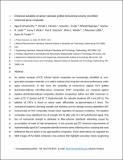| dc.contributor.author | Krishnamurthy, Ajay | |
| dc.contributor.author | Hunston, Donald L. | |
| dc.contributor.author | Forster, Amanda L. | |
| dc.contributor.author | Natarajan, Bharath | |
| dc.contributor.author | Liotta, Andrew H. | |
| dc.contributor.author | Wicks, Sunny S. | |
| dc.contributor.author | Stutzman, Paul E. | |
| dc.contributor.author | Wardle, Brian L. | |
| dc.contributor.author | Liddle, J. Alexander | |
| dc.contributor.author | Forster, Aaron M. | |
| dc.date.accessioned | 2019-07-03T18:10:20Z | |
| dc.date.available | 2019-07-03T18:10:20Z | |
| dc.date.issued | 2017-09-17 | |
| dc.date.submitted | 2017-08-11 | |
| dc.identifier.issn | 0008-6223 | |
| dc.identifier.uri | https://hdl.handle.net/1721.1/121489 | |
| dc.description.abstract | Carbon nanotube (CNT) hierarchical composites are increasingly identified as next-generation aerospace materials, so it is vital to evaluate their long-term structural performance under aging environments. In this work, the durability of hierarchical CNT grafted aluminoborosilicate microfiber-epoxy composites (CNT composites) are compared against aluminoborosilicate composites (baseline composites), before and after immersion in water at 25 °C (hydro) and 60 °C (hydrothermal), for extended durations (90 d and 180 d). The addition of CNTs is found to reduce water diffusivities by approximately 1.5 times. The mechanical properties (bending strength and modulus) and the damage sensing capabilities (DC conductivity) of the CNT composites remain intact regardless of exposure conditions. The baseline composites show significant loss of strength (44%) after only 15 d of hydrothermal aging. This loss of mechanical strength is attributed to fiber-polymer interfacial debonding caused by accumulation of water at elevated temperatures. In situ acoustic and DC electrical measurements of hydrothermally aged CNT composites identify extensive stress-relieving micro-cracking and crack deflections that are absent in the aged baseline composites. SEM images of the failed composite cross-sections highlight secondary matrix toughening mechanisms in the form of CNT pullouts and fractures that enhance the service life of composites. | en_US |
| dc.description.sponsorship | Airbus Group | en_US |
| dc.description.sponsorship | Boeing Company | en_US |
| dc.description.sponsorship | EMBRAER | en_US |
| dc.description.sponsorship | Lockheed Martin | en_US |
| dc.description.sponsorship | Saab (Firm) | en_US |
| dc.description.sponsorship | ANSYS, Inc. | en_US |
| dc.description.sponsorship | Toho Tenax | en_US |
| dc.language.iso | en_US | |
| dc.publisher | Elsevier | en_US |
| dc.relation.isversionof | http://dx.doi.org/10.1016/j.carbon.2017.09.006 | en_US |
| dc.rights | Creative Commons Attribution-NonCommercial-NoDerivs License | en_US |
| dc.rights.uri | http://creativecommons.org/licenses/by-nc-nd/4.0/ | en_US |
| dc.source | Prof. Wardle via Barbara Williams | en_US |
| dc.title | Enhanced durability of carbon nanotube grafted hierarchical ceramic microfiber-reinforced epoxy composites | en_US |
| dc.type | Article | en_US |
| dc.identifier.citation | Krishnamurthy, Ajay, et al. “Enhanced Durability of Carbon Nanotube Grafted Hierarchical Ceramic Microfiber-Reinforced Epoxy Composites.” Carbon 125 (December 2017): 63–75. | en_US |
| dc.contributor.department | Massachusetts Institute of Technology. Department of Materials Science and Engineering | en_US |
| dc.contributor.approver | Wardle, Brian L | en_US |
| dc.relation.journal | Carbon | en_US |
| dc.eprint.version | Author's final manuscript | en_US |
| dc.type.uri | http://purl.org/eprint/type/JournalArticle | en_US |
| eprint.status | http://purl.org/eprint/status/PeerReviewed | en_US |
| dspace.embargo.terms | N | en_US |
| dspace.date.submission | 2019-04-04T10:31:39Z | |
| mit.license | PUBLISHER_CC | en_US |
